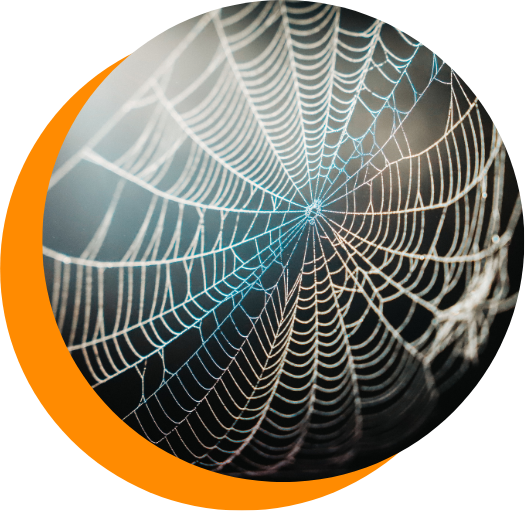Spiders are a common nuisance in both residential and commercial properties, often causing discomfort and anxiety among occupants. Their presence can be more than just an unpleasant experience; it often signifies underlying issues such as infestations of other pests which serve as their food source.
The significance of professional spider control services cannot be overstated. Homeowners and business owners alike face potential risks from infestations, ranging from simple fear and disgust to more serious concerns like bites and the psychological impact of an infestation.
Facts And Folklore
Spider silk is remarkably strong and flexible, often compared to high-grade steel. Some species can produce silk that is stretchier and tougher than Kevlar, the material used in bulletproof vests. Certain species can change color to blend into their environment, a process that can take anywhere from a few days to several weeks. This color change is primarily used as a camouflage tactic against predators. Some perform elaborate dances and rituals to attract mates. These can include complex tapping or drumming on the ground or leaves, intricate dances with their legs, or presenting gifts wrapped in silk.
Superstitions About Spiders
- Killing a spider brings rain. This superstition is widespread in various cultures, linking the killing of spiders to bad weather, particularly rain. There is, of course, no scientific basis to this belief, but it underscores the often-mystical nature of folklore associated with them.
- Seeing a spider at night brings good fortune. Another less common but positive superstition suggests that encountering one at night could indicate good luck. This contrasts sharply with the generally negative perceptions of spiders.
Common Species In Tennessee
Often seen during the early morning dew on their horizontal, sheet-like webs across lawns and gardens, they are typically brown with long, striped legs, reaching up to 0.75 inches in length. These webs feature a funnel-like retreat where the spider hides, ready to pounce on prey such as flies, small moths, and other insects that blunder into their traps. Known for their spectacular, wheel-shaped webs, they can be found in gardens, fields, and forests. They vary widely in color and can grow up to 1 inch in body size. Orb-weavers typically rebuild their webs each day, often eating the old web to conserve proteins and other nutrients.
Unlike many spiders, wolfs do not spin webs to catch their prey. Instead, they rely on their strong, robust bodies and distinct stripes to hunt on the ground. They can grow up to 1.5 inches in size and are known for their remarkable speed and agility, which make them formidable hunters. Active mostly at night, they chase down crickets, ants, and other insects.
The smallest of the group, jumpers are up to 0.5 inches long but make up for their size with their dynamic hunting style. With a compact, stocky build and large, forward-facing eyes, they have excellent vision that aids in their daytime visual hunting tactics. These curious and intelligent spiders stalk their prey before leaping onto them, often jumping many times their body length.
Widow And Recluse
In Tennessee, two of the most notorious species that warrant caution are the Black Widow, and the Brown Recluse. Both are known for their potentially dangerous bites, which makes understanding their behaviors and habitats crucial for safety.
The black widow is perhaps the most feared among the widow species found in Tennessee. Females are known for their potent venom, which can cause severe pain, muscle cramps, and, in rare cases, more serious symptoms. However, fatalities are extremely rare, thanks to the effectiveness of modern medical treatments.
The Brown Recluse spider is another species that is notorious for its venomous bite. They are aptly named for their secretive nature, often hiding in dark, secluded spaces such as closets, attics, and behind furniture. Their bites can cause significant medical issues, including severe skin lesions and systemic reactions, but like black widow bites, they rarely result in death.
Non-Venomous Bites Are Still A Problem
They are often feared for their eerie appearance and unexpected presence and pose several risks that can impact both the well-being and comfort of individuals in infested areas. Despite very few spider bites being potentially fatal to humans,
While most bites are non-lethal and result only in minor symptoms such as redness, swelling, or itching, certain individuals may experience more severe allergic reactions. These reactions can include symptoms such as intense pain at the bite site, dizziness, breathing difficulties, or a rapid heartbeat. Medical attention may be necessary when such symptoms occur, as they can escalate quickly and pose significant health risks.
The presence of spiders often triggers a psychological impact that extends beyond physical dangers. Arachnophobia, or the fear of spiders, is one of the most common phobias. This fear can lead to considerable anxiety, distress, and discomfort, making it difficult for individuals to feel relaxed in their own homes or workplaces.
Don't let spiders take over your home or business. Take control with Dead End Exterminating, where we offer expert, reliable control services tailored to your needs. Whether you're dealing with a full-blown infestation or just want to prevent one, our team uses the latest methods to ensure your space remains spider-free. Contact us today to schedule your consultation.
Frequently Asked Spider Questions
Q1: What is the most colorful spider?
A1: The peacock spider holds the title for being one of the most colorful species. Native to Australia, these tiny spiders are known for their vibrant blue, red, black, and yellow markings. Males display these bright colors in their elaborate courtship dances, where they raise their abdomen like a flag and extend their colorful flaps like a peacock's tail to attract females.
Q2: Which species has 360-degree vision?
A2: Jumping spiders have some of the best vision among arachnids and can see 360 degrees around. This extraordinary visual capability is due to their large, central pair of eyes that provide acute vision and several smaller eyes that are positioned around their head to detect motion from all angles. This helps them spot and stalk prey effectively.
Q3: Can spiders "hear" without ears?
A3: Interestingly, they can detect sound despite not having ears. Research has shown that spiders use the tiny, sensitive hairs on their legs to pick up vibrations and air pressure changes from their environment, effectively "hearing" sounds. This allows them to respond to potential threats or prey approaching them.
All Rights Reserved | Dead End Exterminating

